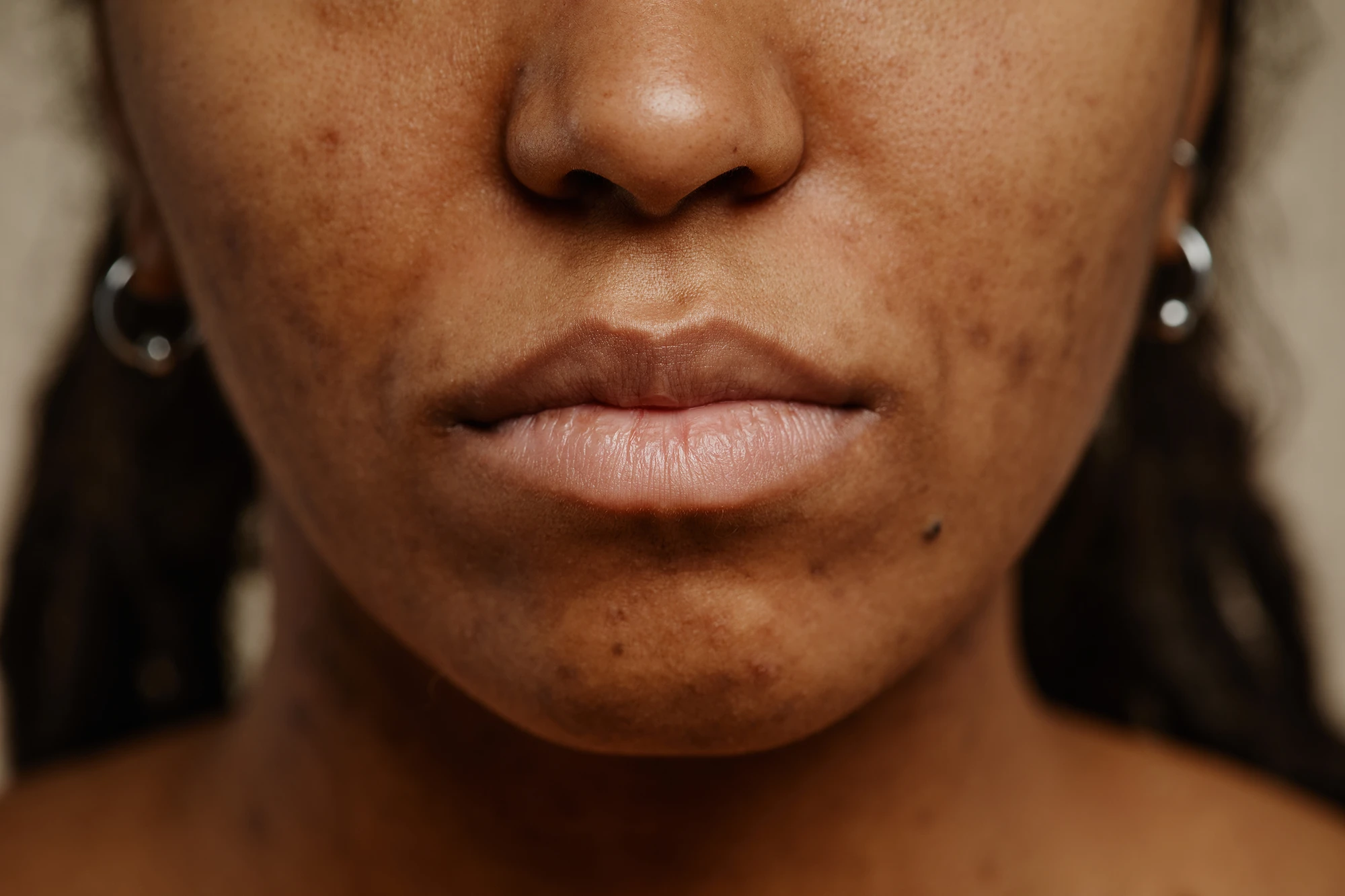Hyperpigmentation Explained: Triggers, Prevention and Treatments
Uncover the root causes of rosacea and persistent redness. Hampstead Aesthetics in West Hampstead offers tailored solutions to calm, treat, and restore balance.
Understanding Pigmentation & Hyperpigmentation
Pigmentation & Hyperpigmentation are common skin concerns that can affect individuals at various stages of life, impacting both skin appearance and confidence. At Hampstead Aesthetics in West Hampstead, we help you uncover the underlying causes of skin discolouration and craft bespoke strategies to calm, treat, and restore balance. Our goal is to empower you to feel confident in your own skin.
What is Pigmentation & Hyperpigmentation?
Pigmentation & Hyperpigmentation refers to areas of the skin that appear darker than their surroundings due to excess melanin production. This can manifest as sun spots, melasma, post-inflammatory marks, or uneven tone. While pigmentation itself is a natural skin function, hyperpigmentation signals an imbalance that often requires professional guidance to resolve. Our team in West Hampstead combines expertise and empathy to guide your recovery journey in a holistic and personalised way.
Types of Hyperpigmentation
- Epidermal: This type involves increased pigment in the upper layers of the skin and tends to respond well to treatments like chemical peels and topical agents.
- Dermal: This type of pigmentation occurs deeper within the skin and is generally more difficult to treat, often requiring more advanced therapies due to its resistance to standard treatments.
- Mixed: Involves both epidermal and dermal pigmentation changes, combining characteristics of both types.
Genetic factors, along with skin tone, particularly in individuals with light brown or dark brown skin, can influence susceptibility to hyperpigmentation.
Types of Hyperpigmentation Concerns
Hyperpigmentation can manifest in various forms, each with its own causes:
Sunspots (Solar Lentigines): Also known as age spots, these dark spots are caused by prolonged sun exposure and typically appear on the face, hands, and shoulders.
Melasma: Characterized by larger patches of pigmentation, melasma is often triggered by hormonal changes and usually appears on the cheeks, forehead, and above the lips.
Post-inflammatory Hyperpigmentation (PIH): These are dark marks that develop after inflammation or injury, such as acne scars, and are more common in medium to darker skin tones.
Common Causes of Hyperpigmentation
There is rarely a single cause of Hyperpigmentation; instead, several common triggers often work together:
- Sun exposure: UV rays stimulate melanin overproduction
- Hormonal changes: pregnancy, contraceptives, and stress can lead to melasma
- Inflammation: spots heal with residual pigmentation, especially after acne
- Genetics and aging: predisposition to pigment issues and slower cell turnover
Other contributors include overly aggressive skincare routines and certain medications that increase photosensitivity.
Signs and Symptoms to Look Out For
Signs of Hyperpigmentation vary in pattern and tone, from small freckles to larger patches on the cheeks, forehead, chin, or hands. You might notice areas that darken with sun exposure or deep-set pigmentation that does not fade with topical creams. Sometimes the pigmentation appears patchy; other times it’s more uniform. Regardless of its presentation, pigmentation can impact self-confidence and may indicate underlying skin conditions that benefit from expert intervention.
Preventive Tips to Support Pigmentation Balance
A strong defence against hyperpigmentation combines daily skincare with professional treatments. To complement your clinic plan, consider these simple practices:
- Use a broad-spectrum SPF each morning, even on overcast days
- Incorporate antioxidants like vitamin C and niacinamide into your routine
- Avoid harsh exfoliants that may trigger further pigmentation
- Maintain hydration and a nutrient-rich diet to support cell renewal
These habits support treatment success and help prevent recurrence over the long term.

Price
£53 per session
Schedule
Monday–Saturday, 10 AM – 7 PM
Best Hyperpigmentation Treatments At Hampstead Aesthetics
Our clinic in West Hampstead offers scientifically advanced treatments to address Hyperpigmentation on multiple levels. Each treatment plan begins with a one-on-one consultation tailored to your skin type and pigment condition.
Q-Switched Laser
Formulated to gently exfoliate deeper layers of the skin, our Q-Switched Laser treatment helps accelerate cell turnover and reduce surface pigmentation. Ideal for sunspots, post-acne marks, and early-stage melasma, this treatment progressively brightens and smooths the skin over a series of sessions.
IPL (Intense Pulsed Light)
Utilizing targeted light energy, IPL treatment breaks down melanin clusters beneath the skin, allowing the body to naturally fade pigmentation. It is especially effective for sun-induced spots and uneven skin tone, with minimal disruption to surrounding skin.
TCA & Glycolic Peels
This combination of skin microchannels and platelet-rich plasma stimulates skin regeneration, improves tone and texture, and gradually fades persistent pigmentation, all while supporting overall skin health.
Tranexamic Acid Infusions (via Microneedling)
Using a blend of calming light wavelengths, this therapy reduces inflammation and supports healthy pigment turnover. It is particularly effective when combined with other pigmentation treatments for enhanced results.
Tranexamic Acid Infusions (via Microneedling)
The Obagi Nu-Derm System is a comprehensive skincare regimen specifically designed to target hyperpigmentation and uneven skin tone. This system includes a series of steps with active ingredients like hydroquinone, tretinoin, and vitamin C, which work together to reduce pigmentation, promote cell turnover, and brighten the complexion for a more even and radiant skin tone.

Why Choose Hampstead Aesthetics for Treating Hyperpigmentation?
We go beyond surface-level solutions. At Hampstead Aesthetics, our practitioners conduct a full assessment of your skin history, lifestyle, and goals. Every treatment is chosen for both efficacy and safety, with a focus on long-term clarity and skin health.
Located in the heart of West Hampstead, our clinic provides a private, welcoming space where every client is treated with care and precision.
From pre-treatment instructions to post-care guidance, we walk with you through every stage of your journey toward healthier, more radiant skin.
Frequently Asked Questions About Hyperpigmentation
How much do pigmentation treatments cost?
Prices vary depending on the method. A medical chemical peel typically ranges from £150 to £300, laser pigment removal starts from £200, and microneedling with PRP is generally £250 to £450. Package pricing is available for multi-session programs.
How many sessions are needed to reduce pigmentation?
Results vary, but most clients benefit from three to six sessions. Visible lightening often begins after the second treatment, with full results developing over two to three months.
Are pigmentation treatments safe for darker skin tones?
Yes, we tailor all procedures to your skin type and Fitzpatrick classification. We use equipment and techniques that minimise the risk of post-inflammatory pigmentation or scarring.
Will pigmentation return after treatment?
Pigmentation may recur if not properly managed. Consistent sun protection, skincare maintenance, and occasional touch-up sessions are key to maintaining results.
Are topical treatments effective for pigmentation?
Yes, treatments like the Obagi Nu-Derm System provide gradual lightening and are especially effective for long-term maintenance.
Can these treatments be combined for better results?
Yes, combining treatments like laser therapy and the Nu-Derm System can provide comprehensive results.
How do I maintain results after treatment?
Consistent sunscreen use and a good skincare routine, including brightening agents, help maintain results and prevent new pigmentation.
Frequently Asked Questions About Fine Lines & Wrinkles
What are the first signs of fine lines & wrinkles I should look out for?
You might start noticing faint lines around your eyes (crow’s feet), across your forehead, or near your mouth when you smile or frown. These are often the earliest signs and usually appear when the skin begins to lose elasticity.
Can I really prevent fine lines & wrinkles, or just slow them down?
While ageing is inevitable, you can absolutely slow down the development of fine lines with the right habits like sun protection, a solid skincare routine, and a balanced lifestyle. Prevention is just as important as treatment.
How do I know which treatment is right for my skin type and age?
Everyone’s skin ages differently. At Hampstead Aesthetics, we assess your skin’s condition, lifestyle, and goals during your consultation to recommend the most effective, personalised options.
Will wrinkle treatments make my face look ‘frozen’ or unnatural?
Not at all. When done correctly, treatments like anti-wrinkle injections or fillers simply soften lines and refresh your features. Our approach is all about subtle, natural-looking enhancement.
Are non-injectable options effective for fine lines & wrinkles?
Yes. Treatments like RF microneedling, chemical peels, and advanced skincare can significantly improve texture and firmness, especially for early or superficial lines.
Is there a right age to start treating fine lines & wrinkles?
There’s no perfect age; it depends on your skin and goals. Some clients start in their late 20s to prevent early signs, while others begin treatment later to restore smoothness and firmness.
Anti-Wrinkle Injections
Tired of struggling with under eye bags?
At Hampstead Aesthetics in West Hampstead, we offer tailored, medically led solutions to revitalise your under-eye area. Book your consultation today and take the first step toward smoother, brighter skin.
Book Your Consultation

